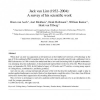281 search results - page 5 / 57 » Learning to Apply Theory of Mind |
AAAI
1994
13 years 8 months ago
1994
We analyze the amount of information needed to carry out model-based recognition tasks, in the context of a probabilistic data collection model, and independently of the recogniti...
HICSS
2007
IEEE
14 years 1 months ago
2007
IEEE
Firms invest heavily to develop on-line cooperative systems in the hope of creating unique value in the minds of their customers. However, when system use begins to decline, firms...
FUIN
2008
13 years 6 months ago
2008
Causal relations are present in many application domains. Causal Probabilistic Logic (CP-logic) is a probabilistic modeling language that is especially designed to express such rel...
JCT
2006
13 years 7 months ago
2006
When Jack van Lint was appointed as full professor at the Eindhoven University of Technology at the age of 26 he combined a PhD in number theory with a very open scientific mind. ...
ATAL
2010
Springer
13 years 8 months ago
2010
Springer
Multi-agent learning is a crucial method to control or find solutions for systems, in which more than one entity needs to be adaptive. In today's interconnected world, such s...

